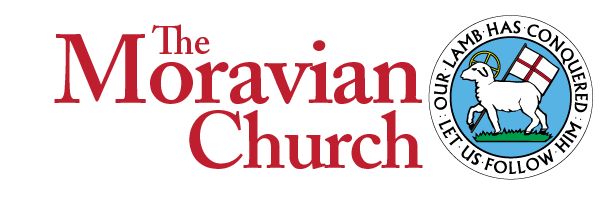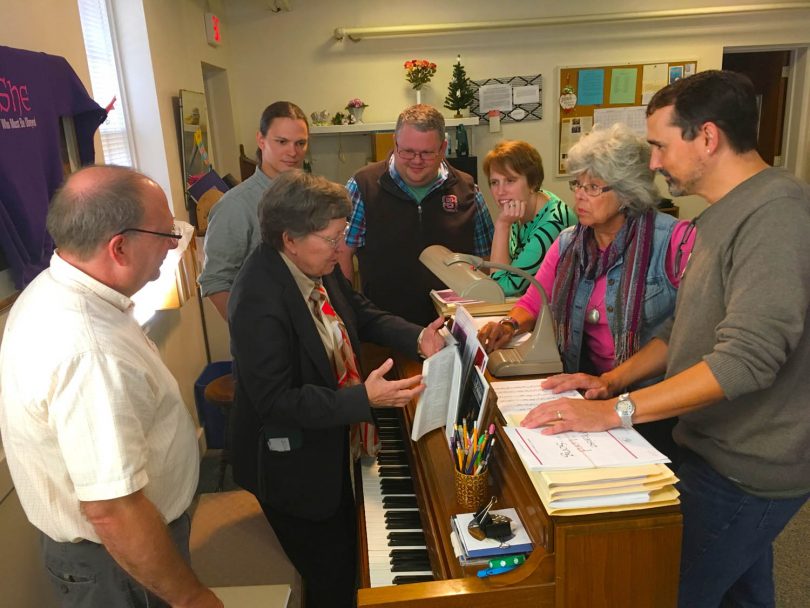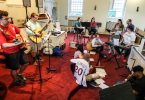Introduction
In the fall of 2016, the Provincial Elders’ Conferences meeting jointly authorized the Rev. Nola Reed Knouse to form a committee, with three members from the Northern and three from the Southern Province, to explore the question of whether it is time for the two provinces to begin work towards a new hymnal. Over the next weeks, Nola invited six people to serve on this committee; all six accepted the invitation (Thomas Baucom, Rev. Rebecca Craver, Rev. Brian Dixon, Rt. Rev. Chris Giesler, Rev. Aaron Linville, and Lillian Britt Shelton), and the committee began work.
The committee met twice in person—in February 2017 in Winston-Salem, and in October 2017 in Bethlehem. During the first meeting, the committee laid out a plan and created two survey instruments: one designed for pastors, music directors, and other worship planners, and the other designed for “general” members of congregations. An article appeared in the March issue of the Moravian, with links to the surveys, and announcements were sent out through provincial and district newsletters and email lists. Members of the committee made presentations at various events to elicit as many responses as possible. Questions on the surveys were designed to find out not only what the respondents thought about the possibility of creating a new worship resource, but also what they are using now, what they would like to use, and what peripheral resources they would find helpful. Responses to many of the questions were readily quantifiable, while others were open questions, allowing an infinite range of responses. Surveys were made available through Survey Monkey, and “hard copies” were made available in a variety of ways.
855 responses were received for the “general” survey, and 254 responses to the “pastor/ music director/worship planner” survey. Several committee members spent hours entering data from the “hard copy” responses, and Thomas Baucom compiled and analyzed the data. At its October meeting, the committee members reviewed all these responses and analyses as well as applying their own considerable experience and insight, to prepare the following observations and recommendations.
1. Neither the survey respondents nor committee members sense a clear need for a new printed hymnal in the near future.
Many indicated that the current Moravian Book of Worship, Singing from the Heart, and Sing to the Lord a New Song have rich worship resources that have not been fully used and that remain both fresh and relevant. We recognize a strong interest in learning to make better use of the resources we already have. Many are interested in more information about the context of the hymns – biographical information about composers and authors, the “story behind the song,” and so on. Many are interested in practical guidance and tools to make better use of the songs and liturgies – copyright clearances, digital versions, editable formats, recordings, and so on. Financial challenges in the congregations seem not to have been a major factor in the responses we received.
2. Responses indicate that the “Moravian worship resource” to be developed is our people, not a new publication.
Many indicated a desire to learn to read music; to write hymn texts, liturgies, and music; how to teach and learn new songs; and to learn more about the printed resources we already have and how to use them. We believe that educating our leaders and our members in worship and music is the greatest need, empowering them to “mine” the existing resources and to find and evaluate new resources. People want to be better educated about what is already available, and to have better access to what is available.
3. We see a need to find ways to encourage, equip and train our members—lay and clergy alike—to create new songs, hymns and liturgies, and a way to share them.
We see a need for some sort of “hub” for Moravian worship development, a sort of “living resource” with information about existing hymns and liturgies and continuing additions to our repertoire. This might include such things as podcasts on a variety of subjects (someone telling how they created a specific liturgy, or telling the story behind several hymns/songs); a lectionary-based database of Moravian worship resources; a study of the scriptural basis of a specific liturgy; a periodical publication to include new materials, information about existing ones, related artwork, “how-to” articles, and so on. This evolves into a place where Moravians can go for whatever they need to plan and develop worship.
4. Many responses, and again our own experience, indicate a need to free the resources we have, especially the Moravian Book of Worship, from the limitations of the printed book.
We need resources available in all technological formats, with copyright permissions for projecting, recording and printing words and music in bulletins. We need the ability to transpose hymns with the touch of a button, and to generate parts for any instrument. We need audio files for at least an identifiable core of Moravian-used music, including the hymns and songs that are uniquely ours as well as the “camp song” and contemporary-style songs that have become a standard part of our larger gatherings. We need simple guitar chords for all our standard hymns and songs. While no one indicated interest in dispensing with the printed hymnal or replacing it altogether, there is a strong desire for more flexibility in access to, and use of, its contents.
Conclusions
This is a very “Moravian” approach to worship and music—focusing on people and process rather than product, and on story and context rather than just the hymn or liturgy as a free-standing entity. We see this as an exciting time for the Moravian Church, with breathtaking enthusiasm and energy at the grassroots level around worship and music. We have noted that throughout our history, the spiritual vitality of the church increases in times of challenge. Singing and worshiping together remain a vital part of our Moravian identity, as the primary means of both forming and expressing our faith as a community.
Implementing these recommendations involves collaboration at a high level, involving the Interprovincial Board of Communication, the Provincial Elders’ Conferences, possibly additional interprovincial-level staffing, and inviting participation with our ecumenical partners. We do not see a need for a specific proposal to synods at this time. We would like to highlight four initiatives that we believe do not need synod action, and which we are beginning to pursue, working within existing channels.
• A “Moravian Worship Journal,” a low-cost periodical publication, with topical issues for which people would be invited to submit articles, liturgies, new songs, and the like.
• Workshops (in-person, online and video) to teach music reading, hymn and liturgy writing, and other topics related to worship, and the development and use of the creative gifts of our members.
• Create In Me: a Moravian Worship Workplace, a new web page or “hub” for music and worship-related topics, hymns, etc., housed either on www.Moravian.org or www.MoravianMusic.org.
• Expanding Moravian Music Festivals to include more workshops relating to worship, geared toward pastors as well as towards musicians.
Respectfully submitted,
The New Moravian Worship Resource Exploration Committee
Related Articles:
• Create in Me…through inspiration, reflection and worship
• Exploring a new song: “Bread of Life, for Others Broken”







